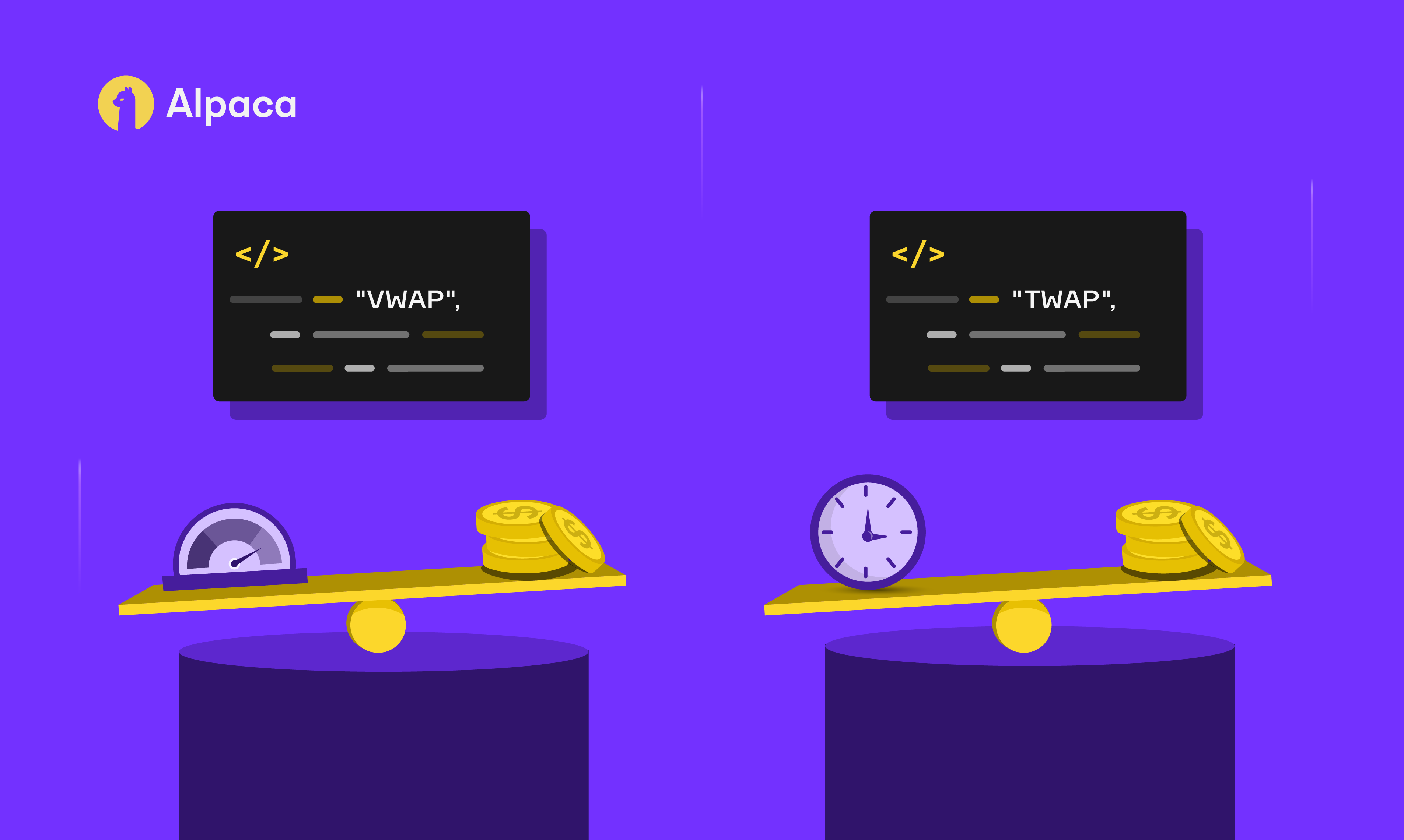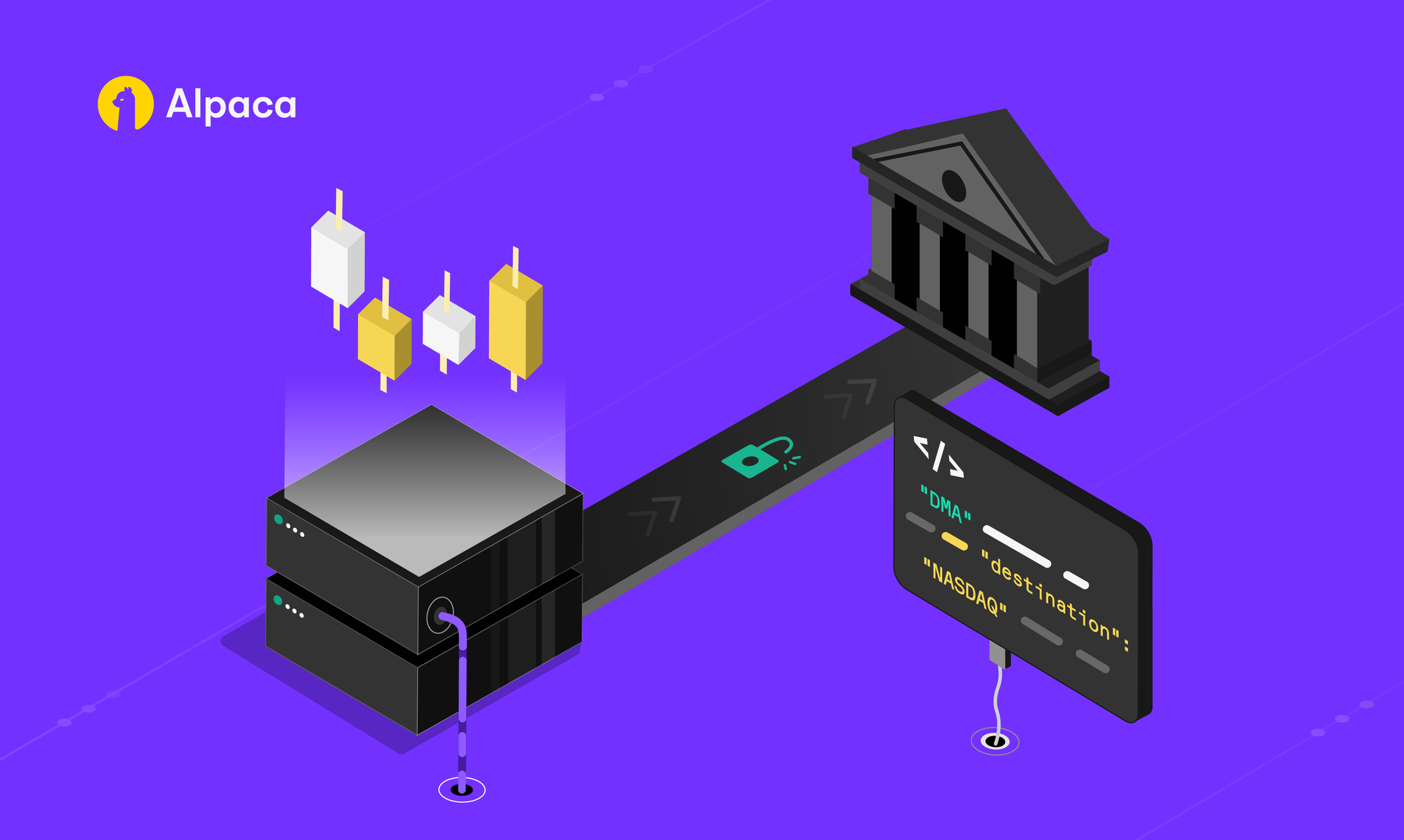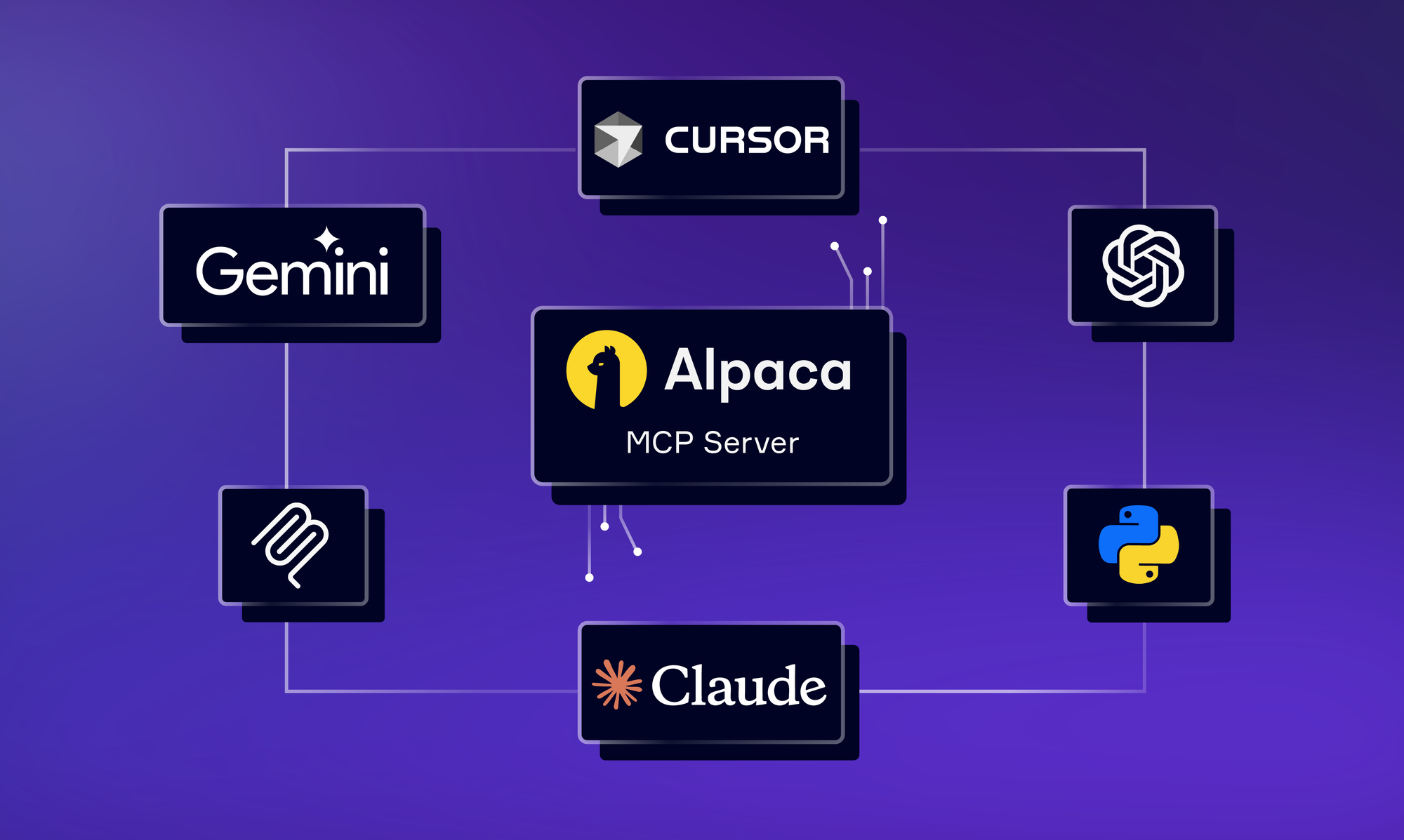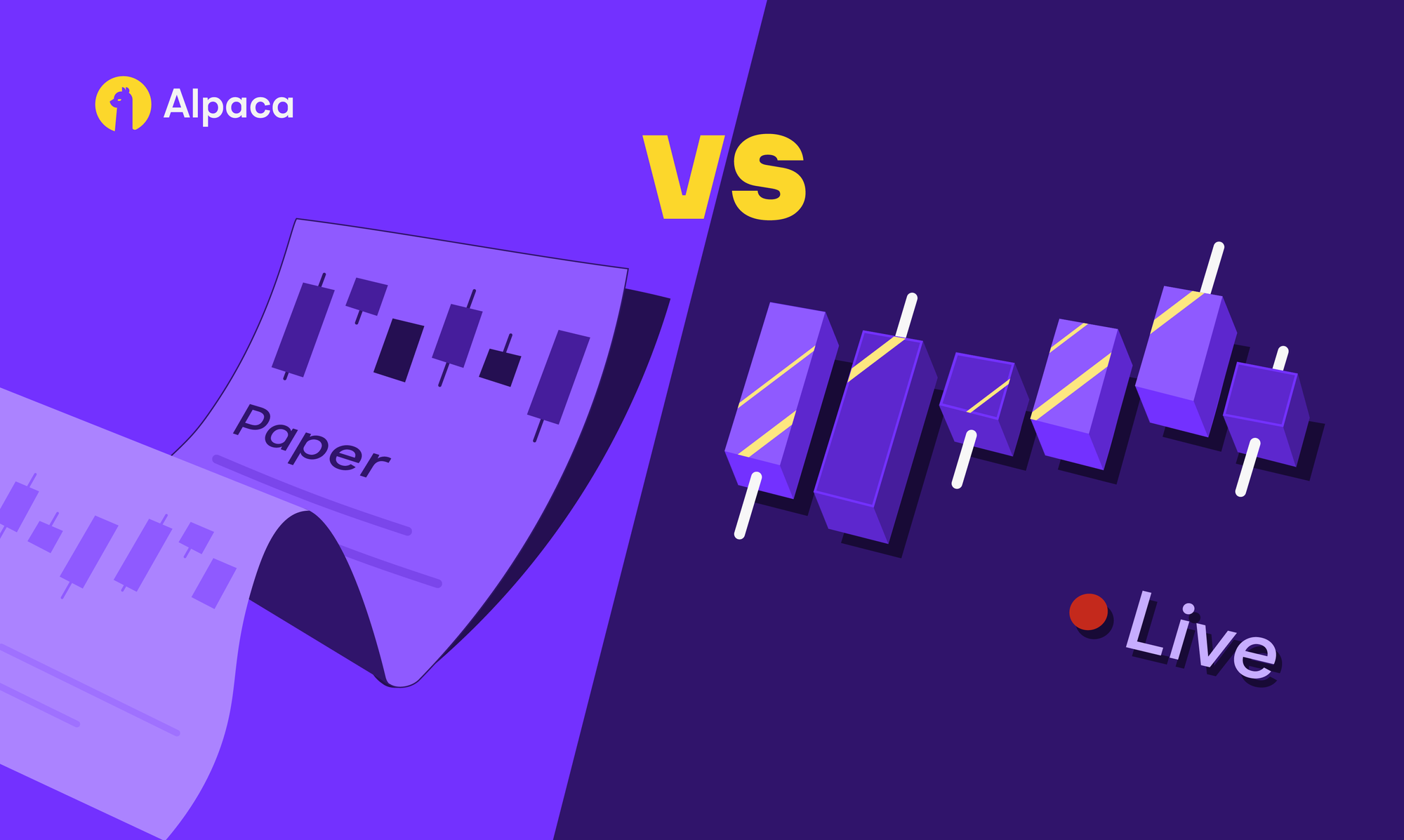Evolution of the Quant Ecosystem
In 2018, we wrote a blog post about the nine great tools for algo trading. At the time, the quant ecosystem had started to gain popularity among individual investors thanks to companies like Quantopian and Quantconnect making it easy to test and trade with algorithms.

Since our last post, the algo trading space has seen a proliferation of new tools and services. As Alpaca was designed from the beginning to cater towards the algorithmic trading market, we thought it was timely to update our post and publish a new landscape.
Algo Trading Journey Segmentation
We segment the ecosystem into different groups:
- Idea Generation
- Media
- Competition
- Market Data
- Backtesting Platform
- Marketplace for Algorithms
- Analytical Tools
- No Code Algo
- API Broker
Do not hesitate to mention us on Twitter at @AlpacaHQ if you have any comments or suggestions on this ecosystem. Thank you!
Idea Generation
Before starting to build algorithmic models, investors need to build an investment thesis that they want to test and potentially later execute. Finding a differentiated strategy is core to generating meaningful alpha.
Quantpedia

Quantpedia describes itself as the encyclopedia of algorithmic and quantitative trading strategies. In essence, they have curated an impressive collection of strategies based on academic research, covering styles, industries and asset classes from around the world in order to make it easy to turn academic research into actionable insights.
Users can leverage Quantpedia screener to browse more than 400 trading strategies as well as its charting tool. The website offers a very helpful resource section including blog, case studies as well as list of their preferred tools.
The premium version has a pricing structure ranging from 299€ for 3 months to 999€ for 3 years.
SSRN

Founded in 1994, SSRN, formerly known as Social Science Research Network, is both a repository for preprints and an international journal devoted to the rapid dissemination of scholarly research in the social sciences and humanities. The platform was acquired by Elsevier in May 2016.
Academic papers in PDF format can be uploaded directly to the SSRN site by authors and are then available around the world via download. Users can also subscribe to abstracting emails covering a broad range of research areas and topic specialties. These distributing emails contain abstracts (with links to the full text where applicable) of papers recently submitted to SSRN in the respective field.
SSRN is free of charge.
Quantocracy

Quantocracy is a curated mashup of trading websites that deal in the quantitative and the empirical. It has become the go to source to follow the best blogs in the algo trading ecosystem. The platform helps readers to keep up with the constant flow of information and make it easy for bloggers to connect with a large audience.
Some examples of blogs aggregated by Quantocracy includes Allocate Smartly, Financial Hacker and Robot Wealth among others
Quantocracy is free.
Quantinstiti

Founded in 2010, Quantinstit started the first algorithmic trading training program in India called EPAT. Today, Quantinsti offers certifications, training authored by industry experts, a proprietary trading platform for backtesting as well as a range of events and resources.
The EPAT curriculum is a great way to learn algorithmic trading as well as to expand one's understanding of the sector with a series of classes such as Python: Quant ecosystem, Equity, FX & Future strategies as well as portfolio management sessions.
For the EPAT® programme batch starting in October, 2020, the standard fee is $6,899. For Indian resident participants the discounted fee is ₹2,64,989 (plus taxes).
Media
Beyond idea generation, investors may be interested in keeping up to date with the broader financial market. Though there are many more financial news publications, the Financial times and Bloomberg are two great sources of information.
Financial Times

The Financial Times is an international daily newspaper printed in broadsheet and published digitally that focuses on business and economic current affairs including blogs such as Alphaville.
The Financial Times has different subscriptions ranging from 1,00 € for 4 weeks to 338,00 € for 1 year.
Bloomberg

Bloomberg delivers business and market news, data, analysis, and video to the world, featuring stories from Businessweek and Bloomberg News.
Bloomberg digital subscription ranges from $1.99/month to $340/year.
Online Trading Competition
Few years ago, there were a number of online trading competitions focused on sourcing and filtering top algorithms. Many of these competitions have stopped operating over the past 12 months (e.g. Quantopian announcement last May).
As such, Alpaca launched its first virtual Electronic Trading Contest, a two week-long contest where participants compete against each other in a simulated market using the Alpaca Paper Trading feature.
Joining an Alpaca Trading Contest is free and only requires having an account at Alpaca. We are working hard on the next competition. Stay tuned!

Market Data
The lifeblood of any algorithmic trading system is, of course, its data. Alpaca wrote a few posts about Market Data APIs such as this introduction, a list of API market data back in 2018 and other posts such that you can find here. Below you can find a list of some of the most popular API Market data.
Barchart

Barchart is a registered market data provider and has provided market data feeds, including real-time, delayed and historical data for over 15 years. Its coverage includes stocks, Mutual Funds, ETFs, Indices, Futures and Forex, more information here.
Barchart offers different pricing based on usage. Contact the team to learn more!
Finnhub

Finnhub offers a real-time RESTful APIs and Websocket for stocks, currencies and crypto. It also provides an institutional-grade alternative and fundamental data for global companies. Its latest addition includes SEC Sentiment Analysis.
Finnhub offers a free subscription and a professional version for $500/month, source.
Tiingo

A financial research platform dedicated to creating innovative financial tools for all. Its API includes end-of-day pricing, newsfeed, crypto data, forex data among others. The company has a range of top clients such as Microsoft, Stake, Quantconnect.
Tiingo has two types of subscription, one for individuals and another for business:
- Individual: Starter $0/month, Power $10/month
- Business: Starter $0/month, Power $50/month
Intrinio

Intrinio offers fundamental, market data and SEC data. The company raised capital from top investors such as NYCA and Wavemaker, and work with a wide range of intech firms, financial institutions, public companies as well as startups.
- Intrinio’s fundamental data includes clean financials for public US companies to simplify one’s data analysis ranging from standardized financial statements, IPOs and metrics & ratios.
- The market data offers a real-time/streaming with 15mn delayed as well as EOD historical data.
- The SEC dataset gives unique insights such as Filing text and search, insider transactions, insider ownership among others
Intrinio does not offer free market data directly on its website. Contact their team directly.
Quandl

Quandl is a marketplace for financial, economic and alternative data delivered in modern formats for today's analysts, including Python, Excel, Matlab, R, and via API. It has become one of the most trusted sources for free and paid data with over 400,000 users.
Quandl offers a free subscription for core data. Financial and Alternative data have different pricing depending on usage. You need to create an account to learn more about the different offerings.
Marketstack

Back in early 2018, marketstack was initially presented under a different name with the aim of providing a free and cost-effective market data alternative to Yahoo Finance. In the course of several years, their REST API has become one of the most popular one-stop shop solutions for real-time, intraday and historical stock data, supporting a total of 125,000+ stock tickers from 72 global stock exchanges, including NASDAQ, Australian Stock Exchange, London Stock Exchange, and many more.
Marketstack offers a free subscription plan including access to 72 exchanges, 1 year history EOD data.
The company also offers additional subscriptions ranging from Basic, to Business and Professional. They are all accessible on their website.
DTN iqfeed

IQfeed is one of the market data leaders with direct access to exchanges. They own and manage their own datacenter providing a true tick-by-tick data feed. They are one of the top providers with more than 80,000 customers.
Some of their market data features include
- Real-Time, TRUE Tick-by-Tick Data on US and Canadian Equities (NYSE, NASDAQ, NYSE MKT, Canadian Stock Exchanges)
- Real-Time Equity/Index Options and Forex Data Available for an additional fee
- Over 700 market stats/breadth indicators (TICK, TRIN, etc), most of which update every 1 second
- 11+ years of 1-Minute OHLCV historical data on exchanges/data authorized depending upon instrument and when we started collecting data
- See full list
The company offers a startup package starting from $50. Additional level data and feature ranges from $20-92/month. See the full list.
Polygon

Polygon was started by ex-Googlers who have a proven track record of building performant, large scale platforms with clean, intuitive usability. The company offers Stocks, Currencies and crypto (level 2 book) market data.
Polygon is one of the most well known players in the quant trading ecosystem. They can accommodate a variety of users and offer a wide range of subscription options, including delayed feeds at $699/month, real-time data for 5 exchanges at $2,000/month, and real time data on all US exchanges for $4,000.
You can subscribe directly on their website.
Tick Data

Founded in 1984, Tick Data is one of the longest standing data providers. The company offers Equity, Futures, Options, Forex and cash indices data. In addition, it also offers reference data, future indices among others.
The equity data ranges from Americas, Europe, Asia-Pacific as well as Middle East-Africa. For example, Tick Data offers historical intraday data for all US equities listed on the NYSE, AMEX, NASDAQ and all other Consolidated Tape Association (CTA) participants since Jan-1-1993, you can find more information here.
The company offers an API but requires a one-year minimum commitment and a minimum monthly charge of $250. Find more information about pricing here.
Backtesting Platform
Once you have an idea and access to market data, you can build your algorithm and run a backtest to simulate your algorithmic strategy. There exists a range of providers that make it easy for investors to run their strategies either via managed-services applications or locally hosted. Alpaca is integrated with many of these applications to make the transition from testing to trading as seamless as possible.
With Alpaca, users can develop their algorithms with multiple languages with SDKs that include python, javascript, GO and C# with many community SDKs [See more information].
Blueshift

Blueshift is a free platform created by the team behind Quantinsti. They are democratising the access to institutional class infrastructure for backtesting and algorithmic trading.
Users can build their own algorithmic trading strategies in python and backtest over 10+ years of data for equities and forex.
The platform is integrated with Alpaca API.
Quantconnect

QuantConnect, is another platform that provides an IDE to both backtest and live-trade algorithmically. Their platform was built using C#, and users have the options to test algorithms in multiple languages, including both C# and Python.
QuantConnect also embraces a great community from all over the world, and provides access to equities, futures, forex and crypto trading. They offer live-trading integration with various names such as InteractiveBrokers, OANDA as well as Alpaca.
The platform has different tier pricing ranging from Quant researcher at $8/month to trading firm at $40/month. You can sign up directly on their website.
The platform is integrated with Alpaca API.
QuantRocket

QuantRocket is a platform that offers both backtesting and live trading with the likes of Alpaca Markets for US equities.
QuantRocket supports multiple backtest engines including its proprietary solution, Moonshot and Moonshot ML for machine learning strategies. It also offers integration with Zipline, the popular backtester powering Quantopian as well as the possibility of connecting other third-party backtesters.
QuantRocket offers a Free plan and a full access and enterprise solution with custom pricing.
The platform is integrated with Alpaca API. Just contact the team to learn more!
Zipline

Quantopian’s IDE is built on the back of Zipline, an open source backtesting engine for trading algorithms. Zipline runs locally, and can be configured to run in virtual environments and Docker containers as well. Zipline comes with all of Quantopian’s functions, but not all of its data. To balance that, users can write custom data to backtest on. Zipline also provides raw data from backtests, allowing for versatile uses of visualization.
Zipline discontinued live trading in 2017, but there is an open source project pylivetrader to run algorithms from Quantopian with Alpaca.
Zipline-live and Zipline-trader are projects that connect zipline to interactive brokers. In essence, it is the exact same interface as zipline, with a wrapper that connects to the IB API.
IBPy

IBPy is an unaffiliated third party python wrapper for Interactive Brokers Trade Workstation API. Before IB started providing their official API library for python, this was the only way to connect to TWS for algorithms written in python.
IB has released an official python SDK, and this library is heading towards becoming obsolete (while still being relevant for python2 users). But there still remain a significant number of live trading engines/tools that still use this library, and it’s good learning material for whoever wants to learn about implementing APIs.
Alpaca Trade API Python SDK is even much simpler to use!
Note, there is a new IB package called IB_insync. It is continuously updated. Have a look.
Backtrader

Backtrader is currently one of the most popular backtesting engines available. It was built using python, and has a clean, simple, and efficient interface that runs locally (no Web Interface). One thing to keep in mind, backtrader doesn’t come with any data, but you can hook up your own market data in csv and other formats pretty easily.
Users can run live trading with Alpaca!
The platform is free. More information here.
Arcade Trader

Arcade trader offers an integrated platform that assists during the entire lifecycle: from the initial spark of an idea to actual live trading of a thoroughly tested algorithmic strategy using funds from your brokerage account.
The platform has a wide range of features ranging from pattern matching, candlestick chart, advanced scanner among others. It can run either in the cloud or on-premise.
Users can execute trades directly via Alpaca.
The platform is free for private and individual traders.
Marketplace for Algorithm
Arcade Trader

As described above, Arcade trader offers an integrated platform for quantitative traders. It will also launch very soon its own marketplace for algorithms.
Collective2

Collective2 is one of the largest marketplace for algorithms. Investors can look through a list of strategies, select the ones they want to use and turn them on in their regular broker account. There is no minimum, no lock ups. On the other hand, the strategy manager gets paid a flat fee for every subscriber who replicates their trades.
The package plan ranges from $19/month to $99/month.
Analytical Tools
Pyfolio

Pyfolio is another open source tool developed by Quantopian that focuses on evaluating a portfolio. What sets Pyfolio apart is its ability to introduce degrees of uncertainty to a static set of data points, and evaluate Bayesian metrics from the user’s portfolio. The Pyfolio API offers a number of visualizations, which can be found on their GitHub repository.
TradingView

Tradingview offers real-time information and market insights via interactive charts. The platform makes it also very easy to share with the Tradingview community which accounts for 11m+ users.
The access on the platform is free to use and access worldwide market data coverage as well as 100k+ technical. Advanced users can have access to more charts, alerts, indicators and other features via premium subscription. You can read more here.
You can also trade directly with Alpaca API on Tradingview. You can read more about this integration here.
Alphalens

Alphalens is also an analysis tool from Quantopian. Unlike Pyfolio, Alphalens works well with the raw data output from Zipline, and rather than evaluate the portfolio, is performance analysis of predictive stock factors. Alphalens has its own range of visualizations found on their GitHub repository.
No Code Algo
A new stream of companies have democratised the access to offer a no-code algorithmic building platform. Anyone can build their own algorithm with just a few clicks.
Streak

Streak offers algorithmic coding without coding, yes you heard it right ZERO CODING required to do algo trading, so you can just focus on finding alpha, and not spend hours and days figuring out how to code a single algo.
With Streak, you can not only Create algos in a minute, but also Backtest in seconds and Deploy them live in the market in just one click. With Alpaca added in your Streak account, now you can take live your best trade idea and invest without having to be glued to the screen.
Read more about the Alpaca integration. Streak is free.
Passiv

Passiv turns a user's brokerage account into a modern portfolio management tool. Users can own personalized indexes, invest and rebalance with the click of a button, and seamlessly manage multiple accounts.
With the power of Alpaca’s API brokerage and Passiv working in sync, Americans are able to build their own free, personalized robo-advisor service (minus the advice) with the two platforms. As a result, they can save on wealth management fees and have more control over their portfolios.
Passiv has two subscriptions: one free and one at $99 / year. Read more about.
API Broker
Once you have translated your idea into an algorithm and run backtest, the next step is to execute your trade. Finding an API broker partner used to be something very difficult for individuals or smaller investment firms. It is for this reason that Alpaca was started and over the past years incumbents have started to launch their own API such as Interactive Brokers.
Alpaca

Alpaca is headquartered in Silicon Valley that offers commission-free stock trading API (Brokerage services are provided by Alpaca Securities LLC, member FINRA/SIPC).
Alpaca paper trading API is available globally. Alpaca live trading API is available for the US residents and invite-only for non-US residents. Alpaca also supports select business entity trading accounts. Please read Account Plans to understand the eligibility.
It is free to open an account. Alpaca also offers free market data if you have a live trading account.
Interactive Brokers

InteractiveBrokers is an online broker-dealer for active traders in general. They have been in the market since 1978. Algo trading isn’t IB’s focus but few backtests have integration with them.
***Do not hesitate to mention us on Twitter at @AlpacaHQ if you have any comments or suggestions on this ecosystem. Thank you!***
Commission-Free trading means that there are no commission charges for Alpaca self-directed individual cash brokerage accounts that trade U.S. listed securities through an API. Relevant SEC and FINRA fees may apply.
Technology and services are offered by AlpacaDB, Inc. Brokerage services are provided by Alpaca Securities LLC (alpaca.markets), member FINRA/SIPC. Alpaca Securities LLC is a wholly-owned subsidiary of AlpacaDB, Inc.
You can find us @AlpacaHQ, if you use twitter.







